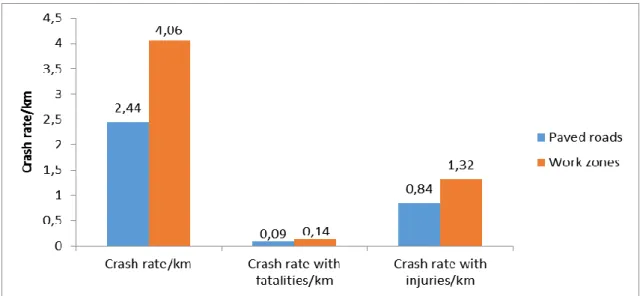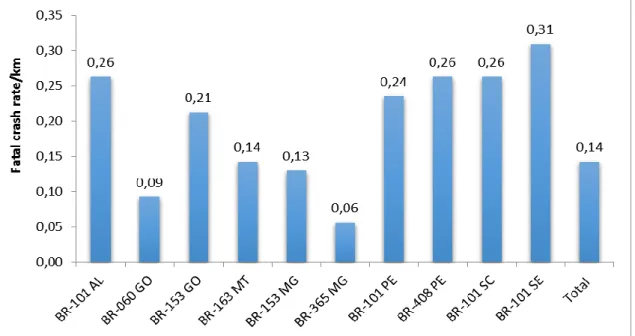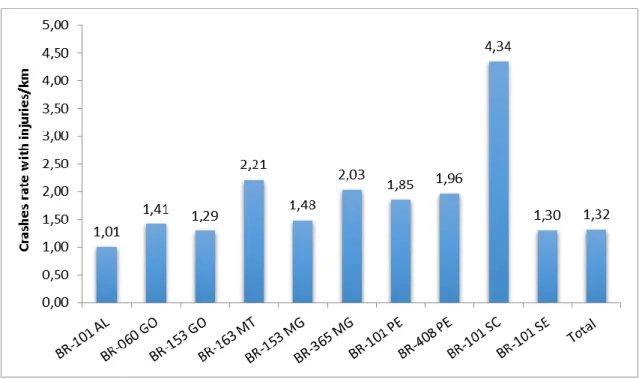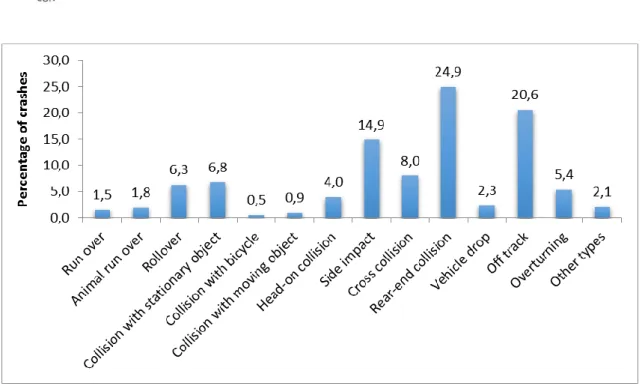TRAFFIC CRASHES IN WORK ZONES: AN OVERVIEW OF THE
BRAZILIAN FEDERAL HIGHWAYS
Camila Belleza Maciel Barreto LabTrans/UFSC Florianópolis, Brazil
Phone: + 55 48 32256960 E-mail: camilabmaciel@gmail.com
Amir Mattar Valente, LabTrans/UFSC; Valter Zanela Tani, LabTrans/UFSC; Carolina Iris Brasil Mariano, LabTrans/UFSC; Ricardo Rogério Reibnitz, LabTrans/UFSC; Flavio De Mori, LabTrans/UFSC
ABSTRACT
This paper presents an overview of work zone crashes in Brazilian federal highways undergoing lane addition. For the purpose of the study, nine segments of highway construction under the jurisdiction of DNIT were analyzed throughout several states in Brazil during the year of 2013. The results show that the accident rate per kilometer in work zone stretches was higher than the accident rate across the entire paved network. While the paved roads had a rate of 2.44 crashes per kilometer, the assessed work zone stretches showed a rate of 4.06 crashes per kilometer. Furthermore, the rate of crashes with injuries and deaths was higher in segments with work zones. This situation can be minimized by implementing more efficient signaling in these segments, as well as the adoption of ITS, seeking to ensure the safety of road users and traffic flow.
1.
INTRODUCTION
According to the United Nations (UN, 2013), 1.3 million traffic-related deaths occurred in one year, this being the ninth leading cause of death worldwide and a major cause of deaths in Brazil. Additionally, traffic crashes result in 20 to 50 million people injured each year worldwide. Only in 2012, according to the Brazilian Ministry of Health (MS, 2013), over 40,000 people lost their lives in traffic accidents in Brazil.
Several studies show that the failure of drivers is the main contributing factor for crashes. However, the publication “A Policy on Geometric Design of Highways and Streets”, known as Green Book (AASHTO 2011), states that the number of crashes increases with increasing number of decisions required of the driver, and this can be related to the road characteristics or signaling.
In this context, highway segments under construction are risky environments for workers and also for users of the road, due to the constant interaction between vehicles and the construction activity. Workers are exposed to vehicular traffic in these segments, with the risk of errant vehicles entering the work zone.
According to the Centers for Disease Control and Prevention (CDC, 2014), from 1995 to 2002, 844 workers were killed at road construction sites in the United States, accounting for more than 100 deaths annually. Out of this total, 91% of the deaths were related to traffic of motorized vehicles or construction equipment, or both.
A recently published article in the journal Traffic Technology International (2015) shows a shocking statistic in the number of deaths of road workers, in order to seek ways to reduce the number of crashes at these sites. This article indicates that work on highways is the most dangerous type of construction, accounting for nearly 5,000 deaths worldwide every year, which means one worker killed every two hours.
In Brazil, despite not having this statistic related to the number of deaths among workers in road construction sites, these numbers can be even more dramatic, since the number of fatalities per kilometer of paved highway and the number of fatalities per vehicle far exceeds the rates observed in more developed countries (WHO, 2014). In this context, this study aims to analyze the occurrence of crashes in stretches undergoing lane addition on Brazilian federal highways in 2013.
2.
WORK ZONES CRASHES
The execution of pavement maintenance and other road works, as well as crashes, are factors that determine the appearance of mobility and safety problems. Such are unexpected situations for those who are driving along the highway in conditions of relatively constant speed.
In work zones, crashes may occur due to the implementation of signaling devices transmitting confusing or contradictory information (AASHTO, 2011). This situation can be exacerbated by the deployment of signs at incorrect distances or the choice and implementation of plumbing devices and inadequate control.
According to analysis of accident data in work zones in the United States in 2008 presented in the report "Identification of Work Zone Crash Characteristics" (FHWA, 2008), one can conclude that 720 road users lost their lives in work zones in that country. Out of this total, the following factors were found as the main causes of crashes:
-
Speeding was a factor in 225 crashes (31%);-
Alcohol was cited as a factor in 146 crashes (20%);-
Time of Day – 60% day (6am to 9pm) and 40% night (9pm to 6am). Injury crashes were more common during day hours.Also according to the report mentioned above with respect to fatal crashes, the following conclusions can be drawn:
-
22% of fatal work zone crashes occurred on urban interstates (compared to 6% of all fatal crashes);-
59% of fatal work zone crashes occurred on roads with speed limit of 55 mph or more (compared to 49% of all fatal crashes);-
41% of crashes were rear-end collisions (compared to 16% of all fatal crashes);-
On average, 85% of deaths in work zones occurred to drivers and passengers in cars.Khattak et al (2001) indicates that work zones in the United States have approximately 700 traffic-related fatalities, 24,000 injury crashes, and 52,000 non-injury crashes every year.
Some authors mention that accident rates increase in the presence of work zones compared to segments under normal conditions. This increase can be attributed to the complexity of traffic control in the work zone due to interruptions of traffic flow, which create various traffic conflicts. However, the exact reasons why many serious crashes occur in segments with work zones are not yet clear. A thorough understanding of the risk factors associated with the occurrence and severity of crashes in work zones is essential for developing effective measures in order to reduce the number of deaths and injuries, and to improve the operation of traffic and safety in these segments of highway.
There is currently a major effort to reduce the number of crashes on Brazilian highways, through the investigation of the factors that contribute to the occurrence of it. In this direction, the Brazilian government launched the "National Plan of Crash Reduction and Road Safety for the Decade of 2011 to2020", established by the United Nations as the “Decade of Action for Road Safety”. This document presents a set of measures to help reduce the mortality rates and injuries from traffic crashes in the country, through the implementation of enforcement actions, education, health, infrastructure and vehicle safety, in short, medium and long term. These measures have directed DNIT’s actions to reduce traffic crashes on Brazilian highways. Among these factors, the influence of road works in crashes can be highlighted as previously mentioned.
3.
ANALYSIS OF WORK ZONES IN BRAZIL
In 2013, the Brazilian federal road network was composed of approximately 120,000 km of roadways, according to Nacional Road System, also known as SNV. Excluding the unpaved and planned roads, the federal network was 75,952 km long. Regarding segments containing work zones on the brazilian federal highways, in 2013, these segments totaled 1,624 km in length. In order to analyze the number of crashes and its respective severity per kilometer of highway, statistical crash data was acquired from Georeferenced System of Roadway Information – SGV (DNIT, 2015). This is an information management tool used by the highway infrastructure division at DNIT.
For this study, highway segments with work zones were selected in Brazil, seeking to cover different regions of the country. In these segments, the number of crashes were analyzed, as well as the number
of deaths and injured and the specific types of crashes. The highway segments analyzed in this study refer to the year 2013, as follows:
-
BR-101 - Alagoas (km 133,70 a km 247,80);-
BR- 060 - Goiás (km 162,10 a km 464,30);-
BR-153 - Goiás (km 565,30 a km 621,70);-
BR-153 - Minas Gerais (km 4,10 a km 58,00);-
BR-365 - Minas Gerais (km 619,80 a km 708,90);-
BR-101 - Pernambuco (km 7,00 a km 41,00);-
BR-408 - Pernambuco (km 64,00 a km 105,80);-
BR-101 - Santa Catarina (km 387,5 a 437,00);-
BR-101 - Sergipe (km 0,00 a km 77,60).The results obtained from the analysis of crashes occurred in segments of work zones in Brazil's federal highways are presented as follows. It should be emphasized that these crashes information may not be accurate as it is not clear the date of completion of the works on the highway.
4.
RESULTS AND DISCUSSION
From the analysis of the total paved network and the number of crashes recorded in these segments (i.e. 18,5675 crashes in 2013) an average of 2,44 crashes per kilometer of paved highway was obtained. Regarding the federal highway network undergoing lane addition, considering the number of crashes recorded in 2013(i.e. 6,600 accidents), an average of 4,06 crashes per kilometer was obtained.
Comparing the crash data occurring across the paved network under the jurisdiction of DNIT and comparing such data with crashes in the paved network under process of lane addition, it appears that the crash rate per kilometer and the number of crashes and injuries and deaths in segments under works of lane addition are well above the rates found for the entire paved network as shown in Figure 1.
By analyzing the data extension of the crashes of the segments under works of lane addition defined in this study, the graph in Figure 2 was obtained.
Figure 2: Crash rates in work zones per kilometer
It was found that the stretch of the highway BR-365, in the state of Minas Gerais stood out along with the stretch of the highway BR-101, in the state of Santa Catarina, with crash rate of 7.22 and 10.91 crashes per kilometer in work zones, respectively. However, when assessing the severity of the crashes, the highway BR-365 in Minas Gerais and the highway BR-060 in Goiás presented values below the fatal crash rate occurring on highways under works of lane addition in Brazil (i.e. 0.06 and 0.09, respectively). The fatal crash rate occurring in work zones is 0.14 deaths per kilometer or 14 crashes with fatalities per 100 kilometers (Figure 3).
By analyzing the number of crashes with injury, an average of 1.32 injury crashes per kilometer has obtained. Values similar to this rate were found in most of the segments presented, except for stretch in Santa Catarina, which had the rate of 4.34 injury crashes per kilometer, as shown in Figure 4.
Figure 4: Rate of crashes with injuries per kilometer in work zones
Also referring to Figure 4, the highways BR-163 in Mato Grosso, BR-365 in Minas Gerais, BR-101 and BR-408 in the state of Pernambuco had a crash with injury rate equal to 2,21; 2.03; 1.85 and 1.96, respectively.
5.
TYPES OF CRASHES OCCURRED IN WORK ZONES
In order to get an overview of the types of crashes on the highways under construction works, the analysis was done on 1376,1 kilometers of segments under processes of lane addition in 2013. By assessing the crashes in numbers, it was found that out of 6,600 crashes in segments in duplication in 2013, 1,645 crashes were rear-end collision type, 1,360 crashes were runway output type and 981 were due to side collisions. As a result, the graph shown in Figure 5 was obtained.
It appears that rear-end collisions leads the ranking of total crashes, accounting for 25% of this total. Second are the accidents due to vehicles running off track, amounting to 21% of total crashes. Side collisions represented 15% of the total, followed by the crashes of cross-collision (8%), collision with stationary object (7%), rollover (6%), overturning (5%) and head-on collision (4%).
Figure 5: Types of crashes in work zones
Although the frontal collision accidents represented 4% of the total crashes (263 crashes), this type of accident accounted for 100 deaths, totaling 32% of all deaths recorded in work zones. Moreover, this type of accident accounted for 10% of the total number of injured (394 injured), as shown in Figure 6.
Figure 6: Type and severity of crashes in work zones
Also in relation to the severity of crashes in work zones, despite run over representing only 1% of all crashes, that is, 98 crashes, this type of accident accounted for 10% of all deaths (34 deaths). Vehicles
running off track accounted for 20,6% of all crashes, representing 18% of the incidents with injured and 9% of deaths recorded on roads under lane addition.
6.
CONCLUSIONS
In 2013, 185,675 crashes in paved federal highways in Brazil were recorded, resulting in 103,062 injuries and 8,374 deaths (DNIT, 2015). Approximately 3,5% of all crashes, 6,600 crashes, were recorded in work zones, although these segments represent just over 2% of the paved highway network. In the segments under construction, the crashes resulted in 3,822 injuries and 312 deaths.
In this context, the specific characteristics of the segments undergoing construction works, including the signs or the inefficiency of it, end up favoring the occurrence of crashes. Thus, in addition to proper planning for the implementation of these types of works and the development of traffic diversion projects, special care should be given to signs in order to obtain a safe control of traffic flow in these sites.
Following this presupposition, a signs for works on highways should:
-
Warn, with the necessary advance, the existence of works or emergencies ahead and the situation which will take place in the roadway;-
Regulate the speed and other conditions for safe operation;-
Canalize and manage the flow of vehicles along the work zone, avoiding conflicting movements and crashes, and minimizing congestion;-
Provide clear, standardized and correct information to road users.According to a magazine report on Traffic Technology International (2015), the signs of a segments of highway in work should be able to warn drivers of the presence of not only works itself but also provide real-time information in case of congestion.
The application of information technology combined with telecommunications and electronics, the operational aspects of urban and road transport has proved a viable alternative in terms of cost-effectiveness and contribute to the sustainability of the transport sector. The union of these areas is called Intelligent Transport Systems, internationally known as ITS, where such systems represent new ways of thinking in the flow of traffic, seeking greater efficiency and safety. ITS systems have a wide range of applications ranging from information systems users, through management of highways, to the development of intelligent vehicles and roads.
According to the FHWA (2007), through the active management of traffic, you can dynamically manage congestion, increasing the efficiency of the way it works and in the safety of workers in those locations. Furthermore, one can cite the increased road capacity, more uniform velocities, more uniform behavior of the driver, more reliable travel time, reduction in primary and secondary crashes, etc. Such a system is operated via computer technology, seeking the best strategies automatically, thus reducing the time in relation to human operation and increasing the safety of the highway.
REFERENCES
American Association of State Highway and Transportation Officials – AASHTO (2011). A Policy on Geometric Design of Highways and Streets. 5th Edition. Washington.
Centers OF Disease Control and Prevention – CDC (2015). Highway work zone safety. <http://www.cdc.gov/niosh/topics/highwayworkzones/>.
Departamento Nacional de Infraestrutura de Transportes – DNIT (2015). Sistema Georreferenciado de Informações viárias. <http://www.labtrans.ufsc.br/sgv/>.
Federal Highway Administration – FHWA (2007). Active Traffic Management: the next step in congestion management. Report FHWA - PL-07-012.
Federal Highway Administration – FHWA (2008). Identification of Work Zone Crash Characteristics. FHWA, 2008
United Nations – UN (2013). <http://www.onu.org.br/>
Traffic Technology International (2015). Workzone safety crisis. February/march/2015. p. 40-48. World Health Organization – WHO (2014). Global Health Observatory Data Repository.
Khattak, A.J.; Council, F.M. (2001). Effects of work zone presence on injury and non-injury crashes. Accident Analysis & Prevention, Volume 34, Issue 1, p.19-29.



